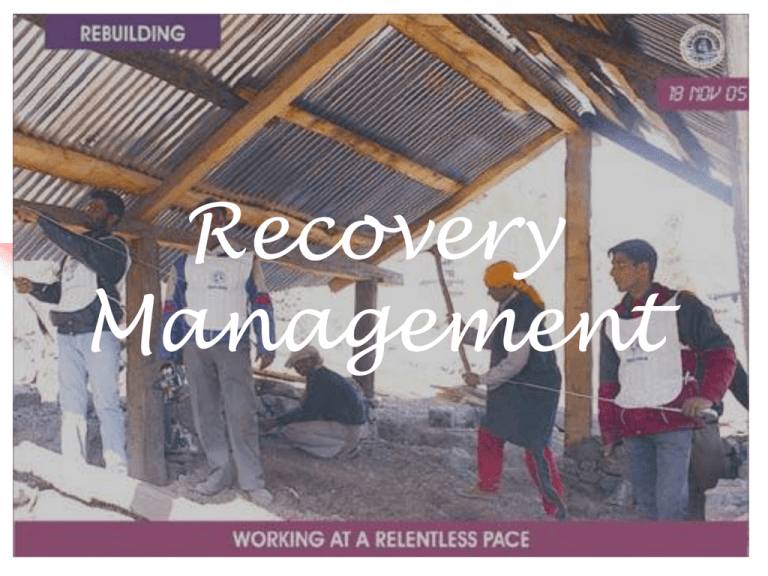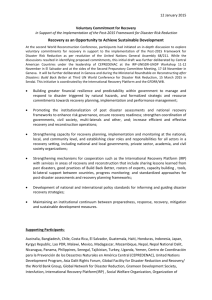Recovery Management
advertisement

Recovery Management 1 Definition Recovery is the process by which communities and the nation are assisted in returning to their proper level of functioning following a disaster 2 *Recovery process can be very protracted. *It includes: * restoration * reconstruction 3 Disaster Analysis – key points No quick finalisation of response/recovery action Potentially long recovery period Financial and material demands usually restrict resources The cumulative effect – the repeated impact of disaster means that the recovery is never really complete and the preparedness remains restricted 4 Transfer of responsibility (response to recovery) The transfer is, in fact, one which perforce takes place between two dissimilar processes Response depends on urgency and short term expediency Recovery has to be of a more general, considered and long-term nature 5 Transfer of responsibility (response to recovery)… response action usually dealing with urgent problems which will not wait. response action often takes place under extraordinary powers, go beyond normal day to day limits of authority. response action must sometimes be taken without consideration of longer term repercussions. e.g., effect on recovery programme 6 Transfer of responsibility (response to recovery)…. some response action may have direct implications for recovery programme. e.g., large scale evacuation response action may have lowered the capability of key govt. depts. recovery action may also have to operate within a changed community attitude 7 Continuation of response activity A further factor in recovery is the need to deal satisfactorily with response activities which continue, or have to be projected, beyond the end of the emergency response period, need to be expeditiously dealt with on two counts: 1. 2. as programme in their own right, in the public and national interest. as part of total strands of relief action from response operations into longer term programme 8 Basis for recovery action Production of an adequate information base to define necessary aspect. Definition of overall strategy for recovery, compatible with proposed and potential national development. Determination of individual recovery programmes within the overall strategy. Implementation of individual programme and projects on well managed and coordinated basis 9 Problem Areas in Recovery Delay in formulation of recovery programme Damage and destruction may be severe and extensive that is difficult, and takes time, to assess and formulate recovery programme Inadequate information Additional load imposed on the govt. 10 Problem Areas in Recovery… Occurrence of another major disaster Problems relating to Ministerial responsibilities may arise Restrictions on availability of finance Political problems Inadequate attention by govt. to public awareness Long time to some major and vital reconstruction programme 11 Problem Areas in Recovery… Resource limitations may apply to the implementation of programme Time process of some of the programme can not be hastened Some of the programme may necessitate substantial reorientation in national activities 12 Requirements for effective recovery Understanding nature of recovery: All concerned authorities should understand the nature of recovery( restoration, reconstruction and rehabilitation) Recovery and national development: where possible , it is desirable to reconcile appropriate aspects of recovery with national development 13 Requirements for effective recovery… The recovery information base: Information from response operations Damage surveys and need assessment Various forms of operational reports Departmental and other reports on completion of emergency phase Information collected by EOC Reports from international assistance agencies Media information Various submissions by individuals 14 Requirements for effective recovery… The recovery information base:… Post disaster review: information can be utilised for recovery programme Information and development programme: recovery requirements may have a direct bearing on existing development plans Information from special teams: special technical advisory team to monitor recovery needs 15 Requirements for effective recovery… The recovery information base:… Information from previous disasters Information for programme parameters: information that affects the shape and size of recovery programme Project cost Time scales In-country input capability, including financial, material and HR International assistance potential 16 17 Requirements for effective recovery… Overall recovery strategy: needs to be made at top govt. level and to include Major areas of recovery needs Envisaged time frame for recovery action Interlinking with national development Broad assessment of resources available Major responsibilities for recovery action System for monitoring from national level 18 Requirements for effective recovery… Assessment of resources International disaster assistance: Direct financial donations, grants etc. Project implementation International welfare agencies or religious body Policy direction of recovery programme: is clearly established and defined- include A special ministerial committee One minister, acting on cabinet direction Cabinet itself 19 Requirements for effective recovery… Determination of programme needs and areas: include Community Reestablishment of social service system Long term rehabilitation of communities and individuals Private sector Industrial system Commercial buildings, stores, shop etc. Government aspects National infrastructure Administrative facilities Education facility Health care Resettlement 20 Requirements for effective recovery… Programme management and monitoring Continuation of emergency relief Programme Disaster management aspects Public and media information Programme decisions and priorities: The type of programme to be implemented The priorities which should apply 21 Human Factors in Recovery Disaster Victims’ Attitudes Devastation Realisation Rationalisation- past, present and future Accusation Accumulation 22 Human Factors in Recovery… Relocation of communities Evacuation Resettlement Personnel injuries and trauma Family bereavement Loss of property and possession Damage to dwellings and, Reduced means of livelihood 23 Gujarat Earthquake UNDP played an active role after the devastating earthquake in January 2001 in overall coordination, support to livelihood restoration and shelter reconstruction. A Transition Recovery Team approach, a new concept of UNDP, has been piloted in India, to assist in the transition between emergency response and longer-term development in earthquake- affected areas. It aims at incorporating vulnerability reduction and sustainable recovery through community-driven programmes by drawing lessons from UNDP’s Latur earthquake reconstruction initiatives. Non-Governmental Organisation (NGO) partners of UNDP such as the Kutch Mahila Vikas Sangathan (KMVS) and the Banaskantha Dwarca Mahila Sewa Association (BDMSA), a part of the Self-Employed Womens' Association (SEWA), were among some of the groups that played a leading role in responding to the earthquake. Women led relief and reconstruction efforts and are now coordinating initiatives to re-establish sustainable livelihoods in the area. 24 The Orissa Super-Cyclone and After The Orissa Super-Cyclone and After In response to the Super- Cyclone in 1999 in Orissa, UNDP along with other UN organisations on the ground provided a coordination support mechanism during the crisis and facilitated interventions in sectors including shelter, agriculture, health, education, women and children, and water and sanitation. The thrust of UNDP interventions in the state is aimed at the realization of what has come to be known as Sustainable Human Development, a term that warrants action on all critical issues in such areas as poverty reduction, employment in the small scale and informal sector, natural resources management including biodiversity, agricultural research, women in agriculture, people’s empowerment, disaster management, and the State Human Development Report (SHDR) initiative. UNDP is currently involved in assistance for rebuilding lives and livelihoods by working in affected blocks for Community-Based Disaster Preparedness, promotion of alternative housing technologies and capacity building of the community for habitat development, Capacity building for empowerment and access to quality services in disaster prone areas through UNITeS IT Volunteers, livelihood support to drought & flood affected communities in Orissa, strengthening coordination and emergency response in vulnerable districts through establishment of control rooms. 25 Summary The multi-purpose approach to recovery programme is worthy of attention from the viewpoint of govt. policy, national development and disaster mitigation/management In formulation of recovery programme, it should be recognised that, in disaster cycle, the four segments which follow recovery are: Development Prevention Mitigation Preparedness 26 Any Questions 27 The End 28







